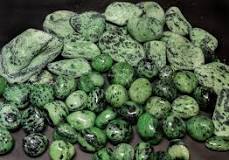
Zoisite: The Colourful Catalyst of Transformation
Zoisite is a stunning and multifaceted mineral loved by rock collectors and crystal enthusiasts for its vivid colour spectrum and transformational energy. Often offering shades from rich forest greens to vibrant lilacs and deep purples, Zoisite captivates both visually and spiritually. As a stone that combines beauty with inner growth, it is a compelling choice for raw crystal jewellery and mineral specimen necklaces, offering depth, contrast, and meaning in one gemstone.

Geological Characteristics: Composition, Structure & Origins
Zoisite belongs to the epidote mineral group and is a complex calcium aluminium hydroxy silicate (Ca₂Al₃(SiO₄)(Si₂O₇)O(OH)). It crystallises in the orthorhombic system, most often found in massive or columnar habits rather than well-formed crystals.
Key Geological Traits:
-
Hardness: 6 – 7 on the Mohs scale, suitable for stable everyday wear
-
Lustre: Vitreous to pearly
-
Transparency: Typically translucent to opaque
-
Colour Varieties:
-
Classic green Zoisite: light to medium green hues
-
Tanzanite: the gem-quality blue–violet variety prized in fine jewellery
-
Ruby in Zoisite (Anyolite): vibrant ruby crystals embedded in green Zoisite matrix
-
-
Primary Sources:
-
Tanzania: Home to both green Zoisite and blue–violet tanzanite
-
Other locales include Kenya, India, Tanzania, and small deposits in Austria and Pakistan
-
Green Zoisite’s speckled green textures complement ruby inclusions beautifully, offering a visually arresting raw specimen. Tanzanite, meanwhile, is often faceted due to its gemstone quality, but raw chunks can be used for unique crystal specimen rings or collars.
Energetic Qualities & Metaphysical Meaning
Zoisite is widely regarded as a stone of energetic expansion, guiding one through emotional healing, creative activation, and spiritual elevation. Different colour ranges influence its energy:
-
Green Zoisite: Heart-centred, supportive of emotional growth and compassion, and align with the heart chakra.
-
Tanzanite: Links throat, third eye, and crown chakras, enhancing intuition, communication of divine insight, and spiritual awakening.
-
Ruby in Zoisite: A powerful combination—ruby energises passion and vitality, while green Zoisite anchors and grounds it, together encouraging mastery of life’s purpose.
Practitioners use Zoisite to:
-
Transform grief or trauma into opportunity and growth
-
Sharpen clarity and analytical thinking
-
Balance the energy body while elevating the spirit
-
Assist with creative inspiration and manifestation
Its balanced, dynamic energy makes Zoisite a standout for healing crystals collections.
Raw Zoisite: The Unique Appeal of Natural Form
Raw Zoisite displays dramatic contrast between vibrant ruby crystals and deep green matrix, or—when tanzanite is showcased—its violet-blue brilliance in uncut, rugged form. These raw qualities make it ideal for mineral specimen jewellery, where:
-
Texture and contrast add visual intrigue
-
Natural inclusions evoke a deeper connection with Earth energies
-
Unaltered cuts preserve the stone’s full energetic resonance
Zoisite lends itself beautifully to handsome crystal specimen rings, pendants, and statement wrap necklaces that honour its organic character. It’s a stone that both stands out and resonates with real emotional depth.
Cultural Resonance & Historical Notes
Though not as deeply embedded in ancient mythologies as some crystals, Zoisite has quietly influenced human imagination for centuries. Its discovery in the 1800s in the Austrian Alps drew attention among mineralogists, but it wasn’t until the 20th century—especially with the emergence of Tanzanite—that it gained broader popularity.
Tanzanite, discovered in 1967 near Mount Kilimanjaro, was quickly embraced as a modern birthstone and regarded as a stone of new beginnings. Maasai lore associates Tanzanite with spiritual communication and mystical insight—qualities mirrored in the gem’s deep violet hues.
Ruby in Zoisite (Anyolite), by contrast, has been linked with life force integration—blending the fire of passion (ruby) with the wisdom of growth (zoisite), making it a symbolic bridge between desire and higher consciousness.
Zoisite Compared to Similar Stones
Zoisite’s chromatic variety and energetic duality can sometimes lead it to be compared with other healing crystals:
-
Chlorite Quartz: Also green and grounding, but more ethereal and light-bodied in frequency
-
Lepidolite: Like tanzanite, aids intuition, but is gentler and lithium-rich, making it ideal for emotional easing
-
Garnet (compared to ruby in zoisite): More primal and dense in energy, while ruby adds vitality with clarity and balance through its matrix partner
Zoisite remains uniquely versatile, particularly due to its dual-natured forms—few crystals span such a wide spectrum of metaphysical uses while offering high collector value in raw form.

Jewellery Use: Where Nature Meets Artisan Craft
Zoisite’s appeal in raw crystal jewellery lies in its organic elegance. Each piece, particularly in mineral specimen rings or necklaces, tells a geological story that transcends time.
Designers who specialise in handmade gemstone rings or mineral specimen jewellery often seek out:
-
Ruby in Zoisite slabs for wrap pendants
-
Raw Tanzanite points for refined yet wild elegance
-
Green Zoisite shards for boho statement rings and earrings
Wearing Zoisite in this form not only creates a tangible connection to Earth’s memory but also supports energetic resonance with one’s personal transformation journey. Raw textures enhance grounding properties while preserving a piece’s unique visual narrative.
At Oryssia, we honour these raw forms with reverence—crafting jewellery that allows the stone’s innate geometry and colour to speak for itself. We believe you don’t wear jewellery, you wear energy.